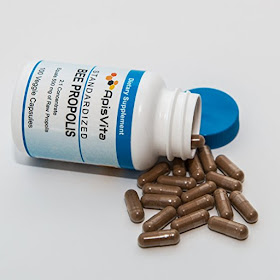Apitherapy News - The Internet's Best Source of Information About the Medicinal Use of Bee Products
Saturday, September 29, 2018
Okinawan Propolis May Help Treat Type 2 Diabetes, Alzheimer's Disease, Cancer
Anti-Inflammatory, Anti-Diabetic, and Anti-Alzheimer's Effects of Prenylated Flavonoids from Okinawa Propolis: An Investigation by Experimental and Computational Studies
Molecules. 2018 Sep 27;23(10). pii: E2479\
BUY Concentrated Propolis in Veggie Capsules
Okinawa propolis (OP) and its major ingredients were reported to have anti-cancer effects and lifespan-extending effects on Caenorhabditis elegans through inactivation of the oncogenic kinase, p21-activated kinase 1 (PAK1).
Herein, five prenylated flavonoids from OP, nymphaeol-A (NA), nymphaeol-B (NB), nymphaeol-C (NC), isonymphaeol-B (INB), and 3'-geranyl-naringenin (GN), were evaluated for their anti-inflammatory, anti-diabetic, and anti-Alzheimer's effects using in vitro techniques. They showed significant anti-inflammatory effects through inhibition of albumin denaturation (half maximal inhibitory concentration (IC50) values of 0.26⁻1.02 µM), nitrite accumulation (IC50 values of 2.4⁻7.0 µM), and cyclooxygenase-2 (COX-2) activity (IC50 values of 11.74⁻24.03 µM). They also strongly suppressed in vitro α-glucosidase enzyme activity with IC50 values of 3.77⁻5.66 µM. However, only INB and NA inhibited acetylcholinesterase significantly compared to the standard drug donepezil, with IC50 values of 7.23 and 7.77 µM, respectively.
Molecular docking results indicated that OP compounds have good binding affinity to the α-glucosidase and acetylcholinesterase proteins, making non-bonded interactions with their active residues and surrounding allosteric residues. In addition, none of the compounds violated Lipinski's rule of five and showed notable toxicity parameters. Density functional theory (DFT)-based global reactivity descriptors demonstrated their high reactive nature along with the kinetic stability.
In conclusion, this combined study suggests that OP components might be beneficial in the treatment of inflammation, type 2 diabetes mellitus, and Alzheimer's disease.

No comments:
Post a Comment